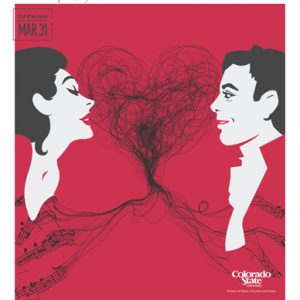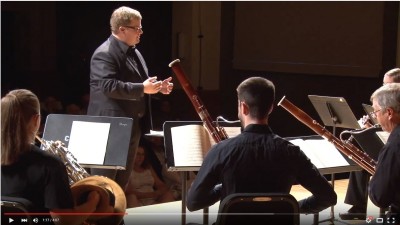
A CSU Favorite Returns to Griffin Concert Hall

James Baumgardner, 2009, B.M. in Music, as Count Almaviva and Cass Mann, 2007, M.M. in Music, as Countess Almaviva in the the 2007 production of Le Nozze di Figaro
The Ralph Opera Center at Colorado State University presents Wolfgang Amadeus Mozart's most famous comic opera, The Marriage of Figaro!
Mozart’s musical genius for melody is married with a witty and wry libretto by his frequent collaborator, librettist Lorenzo da Ponte. The action unfolds at break neck – and frequently complex – speed. The elaborate web of interrelationships and schemes is punctuated by many instances of people hiding behind furniture and characters in disguise as the valet, Figaro, attempts to make his beloved Susanna his wife, much to the chagrin of the Count Almaviva, who is determined to bed her before she is wed.
Often performed at universities, including fully staged productions at CSU in 2007 and 2010, as well as a premiere of a modern-performance edition for chamber winds by CSU’s Dr. Richard Frey in 2012, the classic is a must for both vocal and instrumental students’ repertoire. Plus, audiences adore it!
Selected by Dr. Tiffany Blake, director of the Ralph Opera Center and coordinator of the Voice Area at CSU, because of the educational opportunity for the students to sing in the Classical style, The Marriage of Figaro includes both secco and accompagnato recitatives, as well as special phrasing considerations.
Figaro also features a variety of vocal combinations including arias, duets, trios, sextets, large group finales, and chorus numbers, accompanied by a smaller orchestra. “All of these elements are extremely beneficial to student singers whose technique is not fully developed,” said Blake.

Dr. Richard Frey conducts the CSU Faculty Chamber Winds on the instrumental edition of The Marriage of Figaro in 2012.
“For our purposes, the piece allowed me to cast many singers at a variety of skill levels,” said Blake, particularly referencing the demanding musicality of the leads where the ability to sustain long legato lines, as well as move the voice flexibly in melismatic singing, is required.
Additionally, the comprimario roles are coveted yet manageable, and include pivotal and buffo characters, as well as smaller roles with short but exquisite moments of melodic beauty. Conversely, there is a chorus that allows younger students to be involved.
“With the double casting, we have a cast of 33 vocal students, which is sizable for an opera production,” added Blake.
In Blake’s opinion, because Figaro was revolutionary at its time – depicting lower class servants outwitting their aristocratic masters – it is an important historical piece in the repertoire that should be included in students’ studies.
CSU’s setting of The Marriage of Figaro, inspired by Pierre Beaumarchais’ original 1778 play, is Seville, Spain. Elements of Spanish architecture and late 18th century period fashion are present on the stage, but there is no concrete time period being evoked.
The production is in Italian with English super-titles, making this classic performance, not only requisite to the performers, but easily accessible to youth and first-time opera goers.
We hope you’ll join us on Thursday, March 31, Friday, April 1, and Saturday, April 2, 7:30 p.m., Sunday, April 3, 2 p.m. in Griffin Concert Hall at the University Center for the Arts. Tickets are available at csuartstickets.com.
Accessibility 101
Libretto – text
Secco – minimal accompaniment
Accompagnato – orchestral
accompaniment
Recitatives – sections between
arias that move the plot along
and are sung in the pattern of speech
Arias – melodic solo
Legato – smooth
Melismatic – several notes sung
per syllable
Comprimario – supporting
Buffo – comedic


